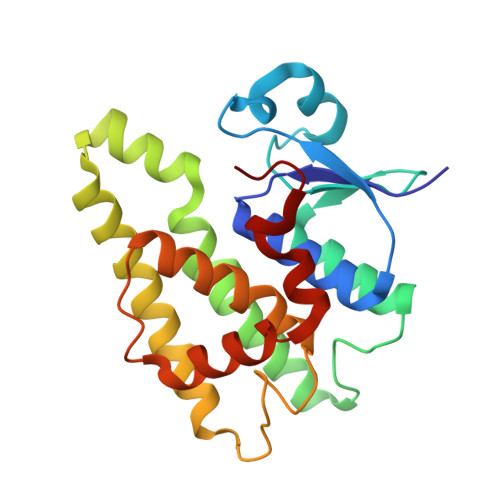Structure of Bacterial Glutathione-S-Transferase Maleyl Pyruvate Isomerase and Implications for Mechanism of Isomerisation.
Marsh, M., Shoemark, D.K., Jacob, A., Robinson, C., Cahill, B., Zhou, N.-Y., Williams, P.A., Hadfield, A.T.(2008) J Mol Biol 384: 165
- PubMed: 18824004
- DOI: https://doi.org/10.1016/j.jmb.2008.09.028
- Primary Citation of Related Structures:
2JL4, 2V6K - PubMed Abstract:
Maleyl pyruvate isomerase (MPI) is a bacterial glutathione S-transferase (GST) from the pathway for degradation of naphthalene via gentisate that enables the bacterium Ralstonia to use polyaromatic hydrocarbons as a sole carbon source. Genome sequencing projects have revealed the presence of large numbers of GSTs in bacterial genomes, often located within gene clusters encoding the degradation of different aromatic compounds. This structure is therefore an example of this under-represented class of enzymes. Unlike many glutathione transferases, the reaction catalysed by MPI is an isomerisation of an aromatic ring breakdown product, and glutathione is a true cofactor rather than a substrate in the reaction. We have solved the structure of the enzyme in complex with dicarboxyethyl glutathione, an analogue of a proposed reaction intermediate, at a resolution of 1.3 A. The structure provides direct evidence that the glutathione thiolate attacks the substrate in the C2 position, with the terminal carboxylate buried at the base of the active site cleft. Our structures suggest that the C1-C2 bond remains fixed so when rotation occurs around the C2-C3 bond the atoms from C4 onwards actually move. We identified a conserved arginine that is likely to stabilize the enolate form of the substrate during the isomerisation. Arginines at either side of the active site cleft can interact with the end of the substrate/product and preferentially stabilise the product. MPI has significant sequence similarity to maleylacetoacetate isomerase (MAAI), which performs an analogous reaction in the catabolism of phenylalanine and tyrosine. The proposed mechanism therefore has relevance to the MAAIs. Significantly, whilst the overall sequence identity is 40% only one of the five residues from the Zeta motif in the active site is conserved. We re-examined the roles of the residues in the active site of both enzymes and the Zeta motif itself.
Organizational Affiliation:
Department of Biochemistry and Centre for Molecular Recognition, University of Bristol, School of Medical Sciences, University Walk, Bristol BS81TD, UK.

















